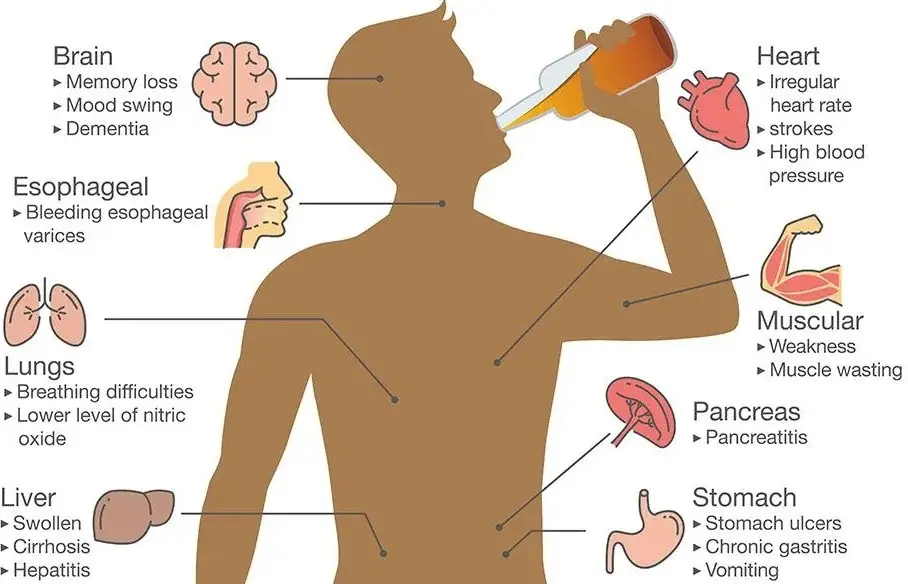Vitamin ever wonder why? The actual name or alcohol used in industry is Ethyl Alcohol (ethanol), as it is used in most of the drugs/medical industries like in making antiseptic, preservatives, and solvent in medication, hand senitizers, pain relief and many more things. For human consumptiuon like alcoholic beverages such as beer, wine and spirits, Etanol is distilled and is prepared for the human use. This Ethanol which is being used in our breverages easily available for consumption are now leading to make our youth and society Alcoholism.
One of the great men had said “It takes only one drink to get me drunk, but the trouble is I can’t remember if it’s the thirteenth or the fourteenth” – George Buras. Alcoholism is characterized by an inability to control alcohol consumption despite negative consequences. It is a chronic disease influenced by genetic, psychological, environmental, and social factors. Alcoholism, or alcohol use disorder (AUD), remains a significant public health issue in the 21st century, with profound implications for individuals, families, and societies. Below is an overview of the issue and its effects:
1. Health Impacts
Physical Health: Alcoholism is a leading cause of liver diseases (e.g., cirrhosis), cardiovascular problems, gastrointestinal disorders, and an increased risk of certain cancers. Chronic use also weakens the immune system.

Mental Health: It exacerbates depression, anxiety, and other mental health disorders. Long-term abuse can lead to brain damage, memory loss, and cognitive impairment.
Addiction: Dependence on alcohol often results in withdrawal symptoms such as tremors, seizures, and hallucinations when attempting to quit.
2. Social and Economic Consequences
Family Dynamics: Alcoholism disrupts relationships, often leading to domestic violence, neglect, and broken families.
Workplace Issues: It causes reduced productivity, absenteeism, and unemployment, impacting both the individual and the economy.Economic Costs: The financial burden of alcohol-related health care, law enforcement, and lost productivity runs into billions annually worldwide.
3. Impact on Society
Crime Rates: Alcohol is a factor in many cases of domestic abuse, sexual violence, and drunk-driving incidents.
Public Health Systems: Hospitals and rehabilitation centers are often overburdened by alcohol-related cases, straining resources.
Youth and Alcoholism: Younger populations are increasingly vulnerable, influenced by peer pressure, media, and easy accessibility.
Alcoholism in the 21st Century
Cultural Shifts
The 21st century has seen changing attitudes toward alcohol, with both normalization through media and growing awareness about its risks. Social drinking culture and stress-related drinking have become more common, especially in urban areas.
Technology and Alcohol Use
Social Media Influence: Platforms often glamorize drinking culture, especially among younger audiences.
Telehealth for Treatment: Technology has also improved access to therapy and support groups, such as online Alcoholics Anonymous meetings.
COVID-19 Pandemic
The pandemic exacerbated alcohol misuse due to stress, isolation, and increased availability of alcohol delivery services, contributing to a rise in AUD cases.
Efforts to Address Alcoholism
Public Awareness Campaigns: Governments and NGOs have launched initiatives to educate people about the risks of excessive drinking.
Policy Measures: Stricter regulations on alcohol sales and advertising.Increased taxes on alcoholic beverages.
Rehabilitation Services: Expanding access to counseling, medical detoxification, and support groups.Community Support: Grassroots movements to reduce stigma and encourage open discussions around alcoholism
Future Challenges and Opportunities
Preventive Measures: Greater focus on youth education and mental health support. Advancing understanding of genetic and environmental factors to develop targeted treatments. Addressing disparities in access to treatment, especially in developing countries.
Collaboration: Partnerships between governments, healthcare providers, and communities to tackle the issue holistically.
Conclusion
Alcoholism in the 21st century remains a multifaceted problem requiring a combination of medical, social, and policy-driven interventions. With increased awareness and support, progress can be made in reducing its prevalence and mitigating its harmful effects.

